12+ Sample Photography Shot Lists
-
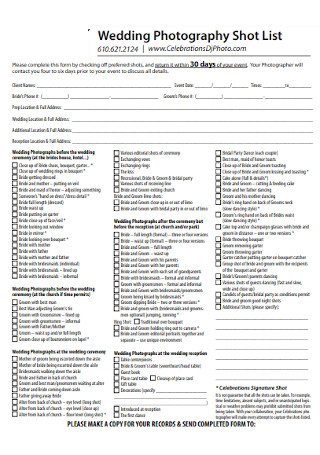
Wedding Photography Shot List
download now -
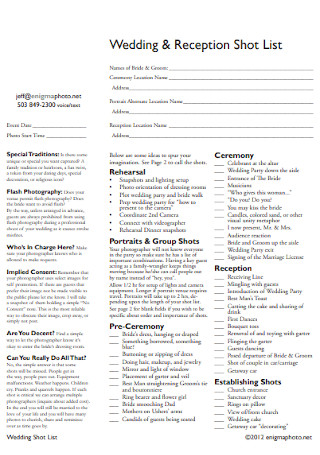
Wedding and Reception Shot List
download now -
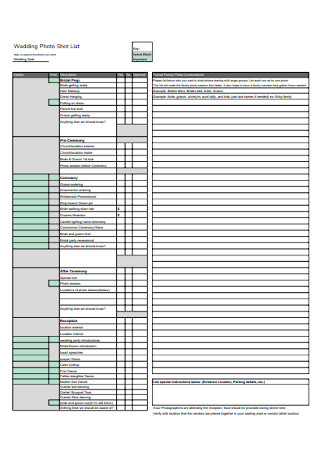
Wedding Photo Shot List
download now -
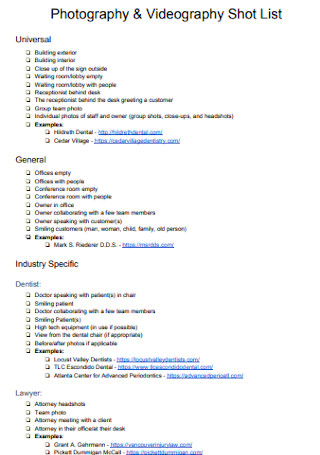
Photography and Videography Shot List
download now -
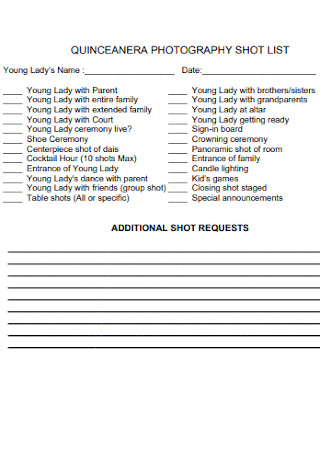
Sample Photography Shot List
download now -

Simple Photographer Shot List
download now -
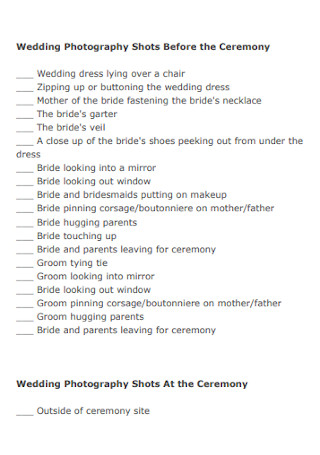
Wedding Ceremony Photography Shots List
download now -
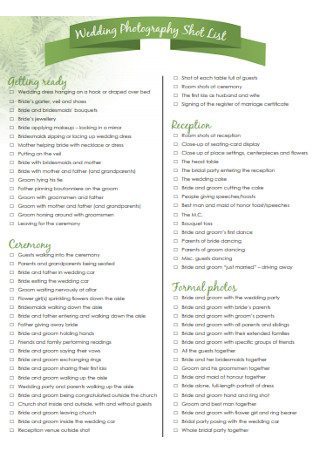
Wedding Photography Shot List Template
download now -
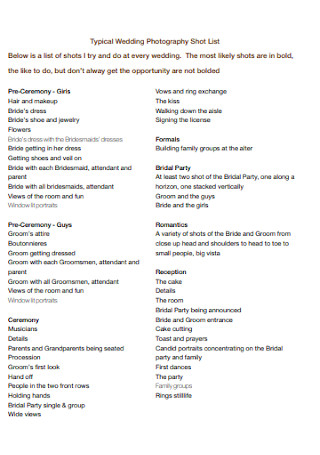
Typical Wedding Photography Shot List
download now -
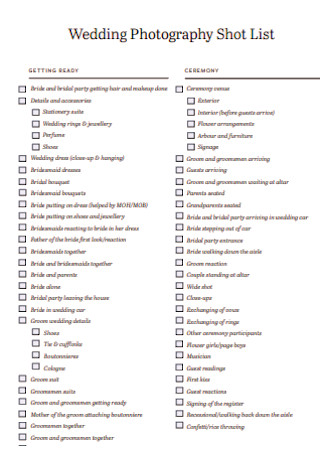
Photography Shot List Format
download now -
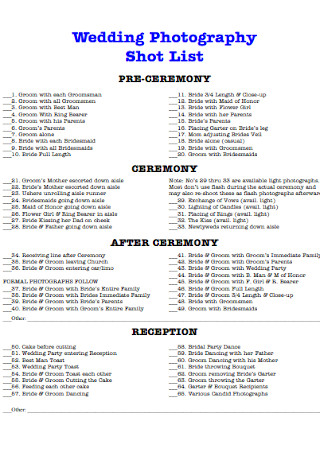
Pre-Ceremony Photography Shot List
download now -
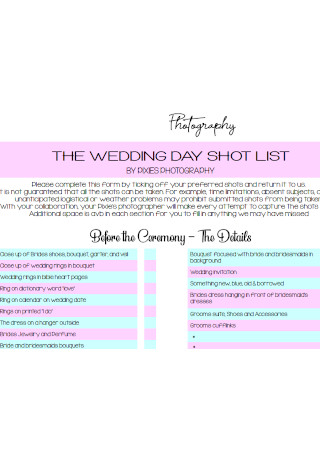
Photography Day Shot List
download now -
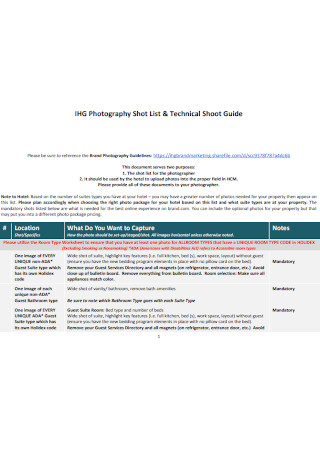
Photography Technical Shot List
download now
FREE Photography Shot List s to Download
12+ Sample Photography Shot Lists
What is a Photography Shot List?
Types of Camera Shots and Camera Angles
Examples of Photography Shot Lists
How to Create a Well-Structured Photography Shot List
FAQs
What are the different types of photography?
What makes a good photography shot?
What are some examples of photography shot lists?
How to make shots more interesting?
What is a Photography Shot List?
A photography shot list is a clear and systematic checklist that is mainly used in coordinating a photoshoot to ensure that specific shots are taken based on the needs and preferences of the client. It assists portrait photographers, food photographers, event photographers, and many types of photographers to fully check, track, and organize particular shots, visual references, and additional details such as camera angles or lighting set-up so that they can carry out all the crucial tasks in their photo sessions without forgetting any important shots on the day.
The major elements in film and photography are camera angles and shots as they can completely transform the story or message that the photographer is trying to convey to the audience. When photographers communicate their artistic view, they consider the direction in which their cameras point, whether the cameras move or stand still and whether they utilize a close-up or extreme long shot. This shot list is made alongside a photography control scope of work and in some photography proposals like a corporate photography proposal and a wedding photography proposal.
Types of Camera Shots and Camera Angles
Planning where the camera will be in your photography sessions helps you to decide what types of shots you will need so that you can tell the story of your subject in the best way possible. Learn and understand different types of camera shots and camera angles.
Examples of Photography Shot Lists
In order to make sure that you don’t miss a shot, photography shot lists guide you to become more efficient and organized while shooting and to help you capture better photos. Here are some common examples of photography shot lists that photographers need to have.
How to Create a Well-Structured Photography Shot List
Stay focused and organized while shooting for your clients. Follow the four steps for creating a well-structured photography shot list.
Step 1: Use a Photography Shot List Template
Look for some sample editable photography shot list templates around the internet. Sample.net contains a wide array of document and checklist templates including well-designed photography shot list templates that you can easily and quickly use for your photo sessions with your clients. Choose from our template collection and download your preferred shot list template for your food, event, portrait, or wedding photography.
Step 2: List the Subjects or Topics of Your Photography
Create a list of the main subjects or topics you want to shoot, as well as what your client wants for the shoot. For example, specify some parts or moments of an event, buildings, or people. Include some reference images or sketches in your list.
Step 3: Note the Specific Shots
The next step is to take note of each specific shot you need. Consider different camera angles, arrangements, formats, and many others. Ask your client what type of camera shots and angles they want aside from your requirements. For example, include in your list full shots, close-ups, and many others. Also, add any special details about the shots you are planning to capture on the day as they act as reminders about the tone, composition, or mood you are aiming for.
Step 4: Describe the Lighting and Backgrounds
Add some descriptive information on the lighting and backgrounds to help you prepare for the day of the shoot in a breeze. Again, consult with your client on their mood board and the visual inspiration they want for the photos. Ask them about the theme they want for the shots as well.
Step 5: Organize, Revise, Share, and Finalize the Shot List
Present your list in the order you want to shoot them. Put all the portrait and solo shots in one section and the group related shots in the other one. Create a column for each segment of your shoot so that you can save time wisely during your photoshoot. Check your list and revise it if necessary. Lastly, share the list with your client and the team so that everyone is on the same page. Collect their feedback and finalize your shot list.
FAQs
The different types of photography are abstract photography, adventure photography, architectural photography, astrophotography, black and white (B&W) photography, business photography, portrait photography, product photography, commercial photography, creative photography, documentary photography, editorial photography, event photography, family photography, fashion photography, film photography, fine art photography, food photography, golden hour photography, time-lapse photography, still-life photography, underwater photography, wedding photography, wildlife photography, and photojournalism.
Make a good photography shot while considering the basic elements to add interest and composition to your shots such as the color, lighting, lines, shapes, patterns, texture, and the rule of thirds.
Some examples of photography shot lists are product shot lists, photography technical shot lists, birthday party photography shot lists, anniversary event photography shot lists, graduation event photography shot lists, family reunion photography shot lists, wedding event photography shot lists, prenup shot lists, food photography shot lists, and many others.
Take candid shots as they produce more genuine and natural photos, get closer to your subject, change your camera angles and objects to create intriguing perspectives, use leading lines to guide the eye of viewers and create stimulating compositions, and use other modes aside from the auto mode such as the full manual mode or aperture priority and shutter priority modes. Get the best results when you slow down, have patience, and take your time while focusing on your shots.
What are the different types of photography?
What makes a good photography shot?
What are some examples of photography shot lists?
How to make shots more interesting?
Whether you are preparing for a commercial, food, event, portrait, or wedding photography, consider executing all the essential points highlighted in this article when you create a simple or detailed photography shot list. Plus, we have included a wide array of sample photography shot lists and other document checklists for your work such as reference lists, quality assurance checklists, and questionnaire checklists that you can easily download and use for your photo sessions and other work projects.
